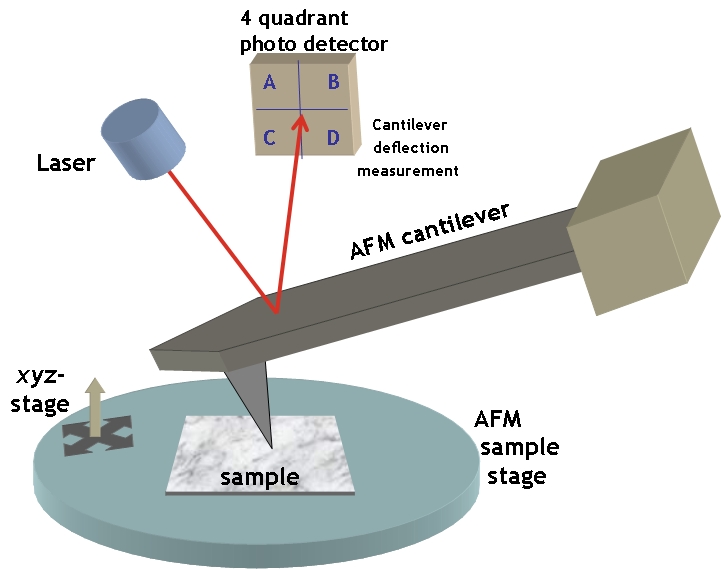My two interviewees are both researching Professors in the Department of Physics. As such the main of their publications take the form of reports on experiments in scientific journals.
Kristian Mølhave How an atomic force microscope works. for the Opensource Handbook of Nanoscience and Nanotechnology 3 October 2013 Wikipedia
CC Attribution 2.5
My first interviewee is Professor Srin Manne. Dr. Manne's research focuses on condensed matter physics and often uses Atomic-force Microscopy(AfM), an imaging technique that can study a material at a far higher resolution than any optical microscope. His publications include entries that instruct in the use of AfM. Dr. Manne is particularly interested in undergraduate research. Dr. Manne is well published, and writes in a variety of fields. Condensed matter research can fall under many different fields.Electrochemistry on a gold surface observed with the atomic force microscope is a paper by Manne et al. on an experiment they conducted observing the oxidation of a gold surface with an AfM. The paper is in the standard form that science students are taught in lab reports. This paper was published in 1991, 9 years after the introduction of the AfM but before many of the advancements in modern AfMs.
Atomic Force Microscopy of the Nacreous Layer in Mollusc Shells in Proceedings of the Royal Society B is a paper by Manne et al. about an experiment studying Mollusk shells with an AfM. This paper follows the same experiment report conventions taught in science classes. The experiment was a cross department and university effort with UC Santa Barbara's Physics, Chemistry, and Biology departments credited, along with the University of Bath's School of Chemistry.
The Company of Biologists Long-range movement of a midbody remnant over the cell surface of HeLa cell. Jan 20, 2015 Youtube
CC Attribution
My second interviewee is Professor Charles Wolgemuth. Dr. Wolgemuth's research studies cellular movement. He studies how individual cells and groups of cells use the laws of physics to propel themselves. He publishes in both Physics and Biology journals.
Crawling Cells Can Close Wounds without Purse Strings or Signaling is a piece by Wolgemuth and Pilhwa Lee. It describes how cuts heal on the cellular level. Better understanding the mechanics of healing could prove important to learning to better treat wounds. The text itself follows the standard experimental report conventions.




